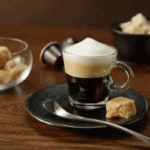Espresso is essentially a combination of two simple ingredients: water and coffee beans. The quality of the coffee beans and water are crucial in achieving a great-tasting espresso. However, did you know that the quality of the coffee beans you use also plays a crucial role in how well your espresso machine performs?
Find out how oily coffee beans can not only affect the taste of your coffee but also how your coffee appliance works.
A Guide to Coffee Roasting
First of all, there are no such things as “espresso beans”. Only coffee beans are involved. Roasting is what makes coffee beans unique. The roasting of coffee beans can range from light to dark.
A coffee bean can be used to make an espresso – espresso is a method of brewing coffee. Espressos are defined by their rich, deep, bold, and smooth taste, but this can only be achieved with beans of medium-dark or dark roast. This type of roast will produce what we consider an espresso complete with a rich, velvety crema.
A major problem with the phenomenon involves the large number of coffee roasters that label their products as “espresso beans”. Unknowing consumers will purchase this item thinking it is compatible with their espresso machine. If they use the espresso machine repeatedly, they will probably find oily and overlydark roasted coffee beans in the bag.
Dark roasts have two main problems:
- There is significant oil on the surface of dark roasts; and
- A dark roast creates a bitter, burnt taste in your coffee.
Understanding the Coffee Roasting Process
It is green when the coffee bean is first planted. According to how long and at what temperature they are roasted, their colour changes. Roasting coffee beans releases oils. The darker the roast, the more oil the bean will have on its surface. The more dark the roast, the more oily it will be. You will actually feel and see that they are greasy.
As a result of this residual oil, your machine components will be coated with it, thus causing the problem. Over time, those oils will compromise the performance of your espresso machine. Furthermore, those very dark roasts will taste bitter and burnt. It is mainly because of the rancid oil buildup that oil becomes foul-tasting over time. Some people who say they don’t like espresso have only ever tried it with overly roasted coffee beans or from a machine in need of repair. Would you like an aftertaste that is bitter and burnt?
What Are the Effects of Oily Beans on Espresso Machines?
Overroasted beans are oily and leave a greasy residue on all your machine components. Imagine the bottom of a frying pan that has residual oil on it. You know how hard it is to clean, don’t you? The same applies to espresso machines. In time, residual oil from oily coffee beans becomes gummy and sticky and adheres to your machine’s components. The longer the oil remains on the surface, the more difficult it is to remove.
Here are some issues that will arise if you use overly oily coffee beans in your espresso machine. Here are a few things you may notice:
- Bean hoppers with sticky surfaces will prevent coffee beans from flowing smoothly into the grinder.
- It is common for coffee grounds to become solid and clay-like when grinding machines become gummed up.
- A clogged screen on a brew unit, portafilter, or even mocha pot will interrupt the flow of coffee.
It won’t be a matter of if, but when, your espresso machine will need servicing if you use oily beans. So if you’ve been using oily beans, make sure to have your machine thoroughly cleaned by an authorized service center, and use the right beans from now on.
What Effect Will Oily Beans Have on the Taste of Your Coffee?
Besides the coffee tasting burnt because the beans are overroasted, the oils that accumulate on machine components over time will also become rancid. It is certain that rancid oil will produce a foul-tasting coffee. It will certainly leave an unpleasant aftertaste. If you are looking for the best coffee beans for espresso, we have some recommendations for you.
What to Look for In Coffee Beans for An Espresso Machine
When choosing beans for your espresso machine or other coffee appliance, consider:
- For the roast: you want a medium roast to a medium roast. Do not assume that beans labeled espresso are necessarily the correct roast.
- Looking at and feeling the beans: If there is a lot of oil on the surface of the beans and they feel oily, then the beans are not suitable for your espresso machine.
- Blends of coffee beans: each bean variety responds differently to roasting. Some varieties naturally produce more oil than others. Buying coffee blends balances the amount of oil in the beans. The oil in coffee beans contributes to the flavour and body of the coffee it will produce. Crema, a hallmark of a good espresso, is also the result of emulsified oils.
Was this helpful?
Hi there! I’m a food enthusiast and journalist, and I have a real passion for food that goes beyond the kitchen. I love my dream job and I’m lucky enough to be able to share my knowledge with readers of several large media outlets. My specialty is writing engaging food-related content, and I take pride in being able to connect with my audience. I’m known for my creativity in the kitchen, and I’m confident that I can be the perfect guide for anyone looking to take their culinary journey to the next level.








